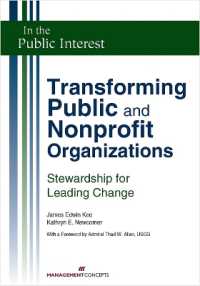Full Description
Fitness education is often overlooked for various reasons: no equipment, no weight room, large class size, or lack of professional development.
Designing and Teaching Fitness Education Courses provides real solutions for all these issues. This book offers secondary-level physical educators innovative ideas, practical answers, and guidance in implementing fitness education programming that will meet the needs of all students.
Designing and Teaching Fitness Education Courses is packed with highly useful tools and resources:
211 instructional photos showing exercises and stretches that require no equipment and are easily adapted for varying abilities
18 pacing guides that form a week-by-week blueprint for implementing a semester-long fitness education course
A robust online resource with
all 18 pacing guides, as well as a blank template for developing your own;
139 video demonstrations of all the book's exercises and stretches;
PowerPoint presentations to show in PE classes, including video demonstrations of the book's exercises and stretches; and
teacher aids and student handouts, including assignments, assessments, posters, and a 12-week personal fitness plan
Teachers can use the pacing guides to develop a semester-long fitness education course that can be implemented in either a traditional or block schedule. These guides offer objectives, class discussion topics, activities, assessments, and teaching strategies for each week of an 18-week semester. All topics in the guides are aligned with SHAPE America's National Standards and Grade-Level Outcomes for K-12 Physical Education.
The authors guide teachers in addressing the following priorities within a fitness education course: social and emotional learning; behavior modification principles and adherence to fitness activities; social cognitive theory; classroom management; student safety; equity, diversity, and inclusion; and social justice.
Designing and Teaching Fitness Education Courses also includes a detailed chapter on nutrition education written by internationally recognized sport nutritionist Lisa Dorfman, who provides teachers a wealth of information to integrate into fitness courses.
Teachers will learn how to integrate a quality fitness education curriculum into any setting (rural, urban, or suburban) and any learning model (remote, hybrid, or in-person learning).
Designing and Teaching Fitness Education Courses is organized into three sections:
Part I presents both theoretical and practical knowledge of fitness education; its importance in a standards-based curriculum; pedagogical and content knowledge considerations; nutrition, wellness, and consumer issues; and the general components of fitness education.
Part II focuses on various components of fitness education: flexibility, strength, and cardiorespiratory fitness. This part includes stretching and muscular strength and endurance workouts, illustrated with photos in the book and videos in the online resource.
Part III guides readers in enabling students to participate in community fitness and activity events to support the development of lifelong fitness habits.
Through Designing and Teaching Fitness Education Courses, teachers will be able to provide appropriate fitness activities that will lead to the elevated health and wellness of students and a greater appreciation for participating in lifelong activities.
Note: A code for accessing HKPropel is included with all new print books.
Contents
Part I. Foundations of Fitness Education
Chapter 1. Introduction to Fitness Education
Introduction
Physical Education and Fitness Education: What Is the Difference?
Why Fitness Education?
Implementing Fitness Education
Fitness Education Barriers and Solutions
Roles and Responsibilities in Fitness Education
Conclusion
Review Questions
Chapter 2. Fitness Components and Training Principles
Introduction
The Components of Physical Fitness
The Basic Principles of Training
Exercise Fitness Planning: Designing the Training to FITT the Goal
Training Methods for the Components of Fitness
Conclusion
Review Questions
Chapter 3. Curricular and Instructional Considerations in Fitness Education
Introduction
Content Knowledge and Pedagogical Content Knowledge
Designing an Instructional Framework
Employing a Variety of Teaching Strategies
Modifying Learning Tasks: A Universal Design for Learning Approach
The Instructional Delivery Process
Providing Performance Feedback
Characteristics of Effective Feedback
Conclusion
Review Questions
Chapter 4. Classroom Considerations and Teaching Tips
Introduction
General Class and Teaching Considerations
Supervision, Safety, and Environmental Factors
Equity, Diversity, Inclusion, and Social Justice
Conclusion
Review Questions
Chapter 5. Nutrition, Wellness, and Consumer Issues
Introduction
Nutritional Needs in Adolescence
Nutrition Education
Daily Calorie Needs for Weight Management
Healthy Weight Range
Dieting and Eating Disorders
Dietary Composition
Special Diet Concerns
Gluten Intolerance and Sensitivity
Vegetarian Diets
Supplements and Steroids
Adolescent Stress
Sleep
Alcohol
Breakfast and Snacks for Optimal Health and Performance
Becoming a Smart Consumer
Sample Menus
Conclusion
Chapter 6. Social and Emotional Learning
Introduction
Creating a Positive and Motivational Learning Environment
Trauma-Informed Teaching
Developing Social and Emotional Learning
Interpersonal Competencies: Social Awareness
Interpersonal Competencies: Relationship Skills
Cognitive Competencies: Responsible Decision Making
Intrapersonal Competencies: Self-Awareness
Intrapersonal Competencies: Self-Management Skills
Conclusion
Review Questions
Chapter 7. Standards, Grade-Level Outcomes, and Assessment
Introduction
Fitness Education Assessment Strategies
Rubrics
SOFIT Observation Assessment
Alternative Assessments
Use of Technology in Student Learning and Assessment
Fitness Education Grading
Health-Related Fitness Assessments
FitnessGram
Brockport Physical Fitness Test
Lab Fitness Assessments and Career Opportunities
Developing an Individual Fitness Plan
Conclusion
Review Questions
Part II. Fitness Elements and Lesson Plans
Chapter 8. Cardiorespiratory Fitness
Introduction
Benefits of Cardiorespiratory Fitness
Starting Points for a Fitness Education Course
Cardiorespiratory Endurance, Aerobic and Anaerobic Activities, and MVPA
Inclusion
Methods of Cardiorespiratory Training
Safety Guidelines
Monitoring and Assessment
Teaching Tips
Conclusion
Review Questions
Chapter 9. Upper-Body Stretching Exercises
Introduction
Warm-Up Dynamic and Static Stretches for the Upper Body
Routines: Stringing Them Together
Teaching Tips
Conclusion
Review Questions
Chapter 10. Core Stretching Exercises
Introduction
Warm-Up Dynamic and Static Stretches for the Core
Routines: Stringing Them Together
Teaching Tips
Conclusion
Review Questions
Chapter 11. Lower-Body Stretching Exercises
Introduction
Warm-Up Dynamic and Static Stretches for the Lower Body Routines: Stringing Them Together
Teaching Tips
Conclusion
Review Questions
Chapter 12. Upper-Body Muscular Strength and Endurance Exercises
Introduction
Warm-Up Dynamic Stretches
Upper-Body Muscular Strength and Endurance Exercises
Cool-Down Static Stretches
Routines: Stringing Them Together
Teaching Tips
Conclusion
Review Questions
Chapter 13. Core Muscular Strength and Endurance Exercises
Introduction
Warm-Up Dynamic Stretches
Core Muscular Strength and Endurance Exercises
Cool-Down Static Stretches
Routines: Stringing Them Together
Teaching Tips
Conclusion
Review Questions
Chapter 14. Lower-Body Muscular Strength and Endurance Exercises
Introduction
Warm-Up Dynamic Stretches
Lower-Body Muscular Strength and Endurance Exercises
Cool-Down Static Stretches
Routines: Stringing Them Together
Teaching Tips
Conclusion
Review Questions
Chapter 15. Implementing the Fitness Education Program
Incorporating Cardiorespiratory Fitness Into Routines and Circuits
Methods of Fitness Training
Sample Lesson Plans
Teaching Tips
Conclusion
Review Questions
Part III. Extending Fitness Education
Chapter 16. Extending Fitness Education Into the Community
Introduction
Connecting Community Events to Schools
Community-Based Programs and Activities
Inclusion Tips for Community-Based Programs
Training for a Road Race
Conclusion
Review Questions
Chapter 17. Pacing Guides for Semester Planning
How to Use the Pacing Guides
Pacing Guides: Weeks 1-18
Conclusion








